
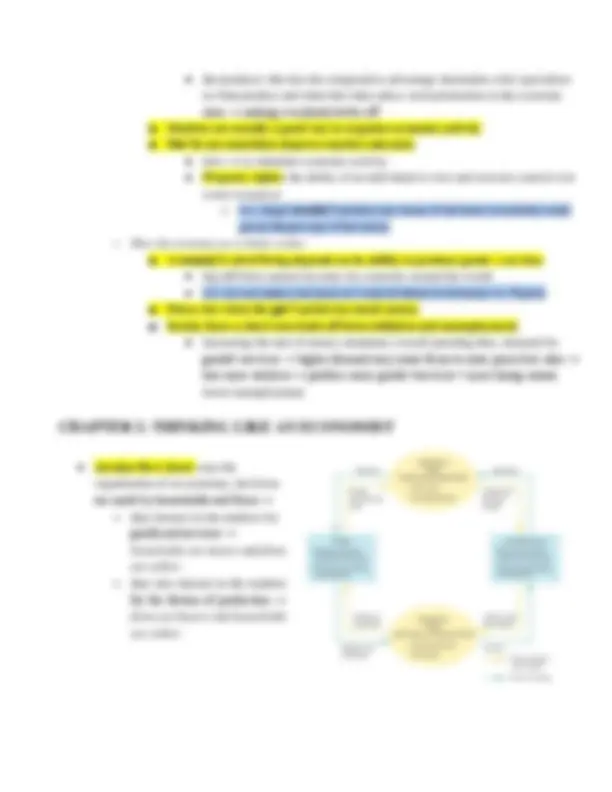
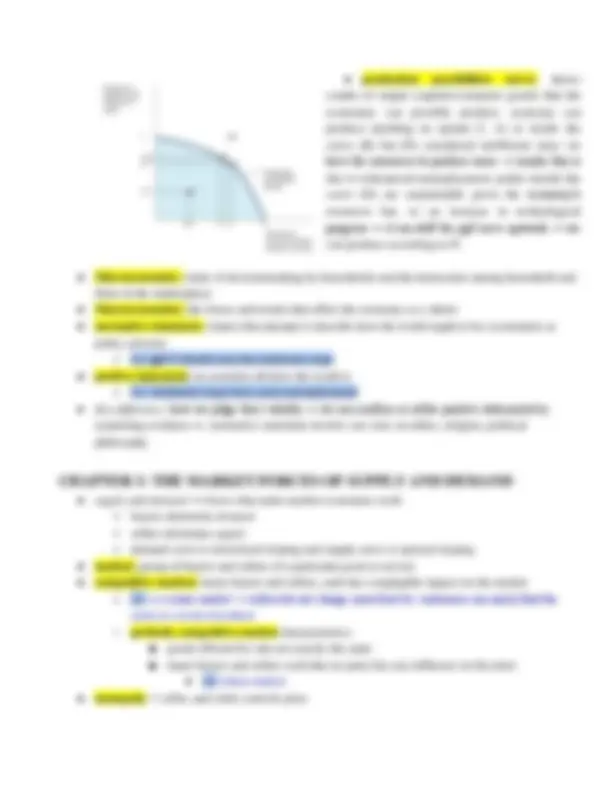
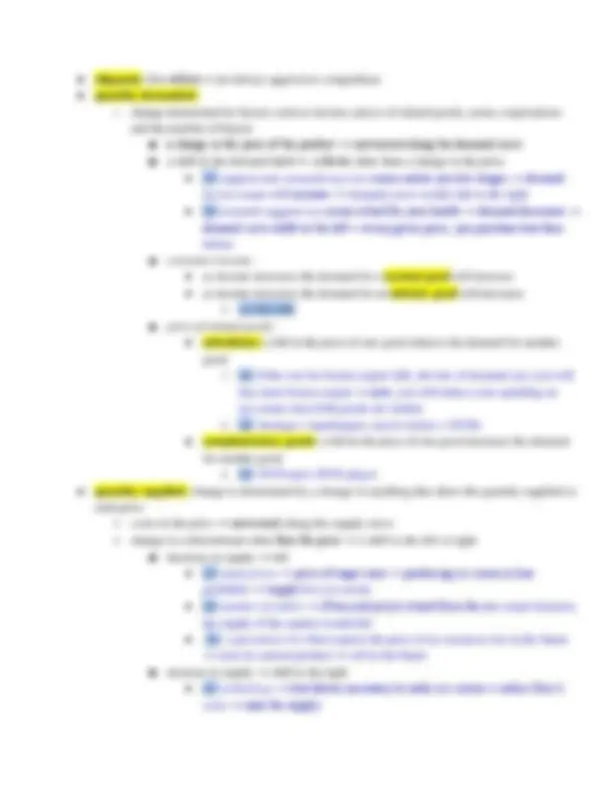
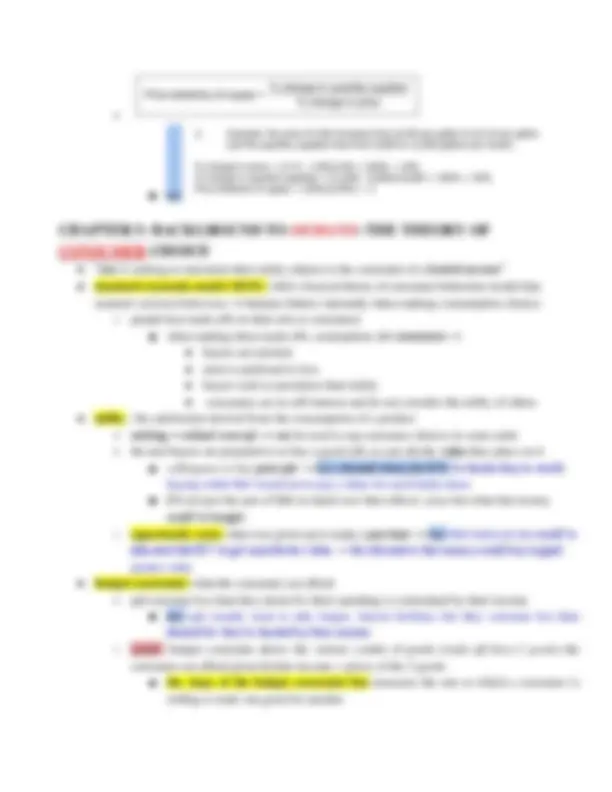
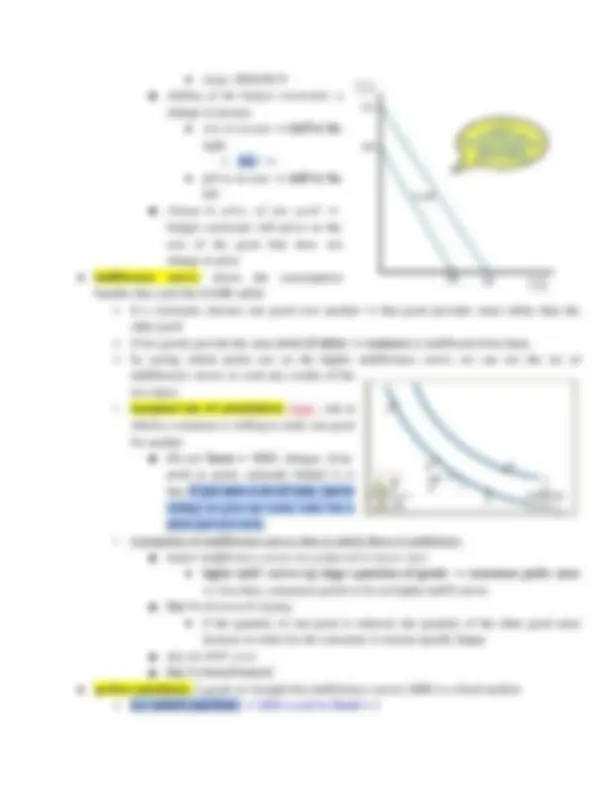
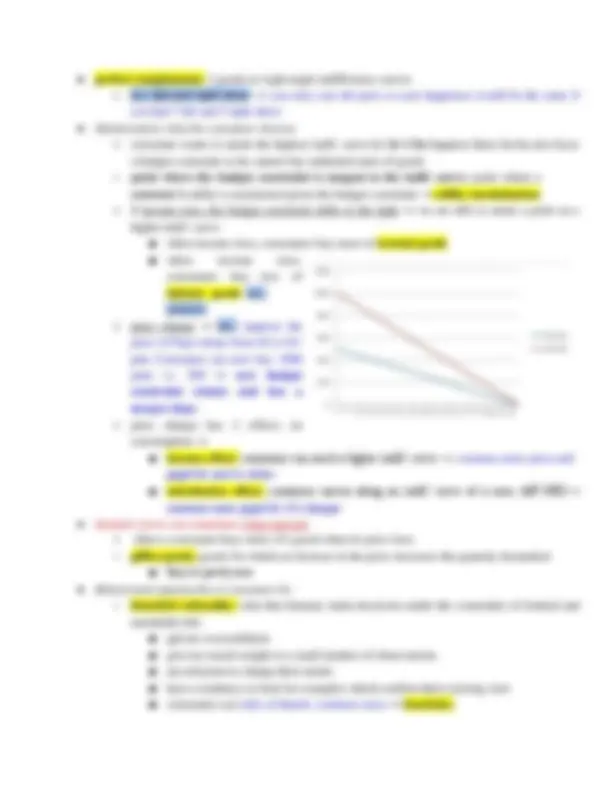
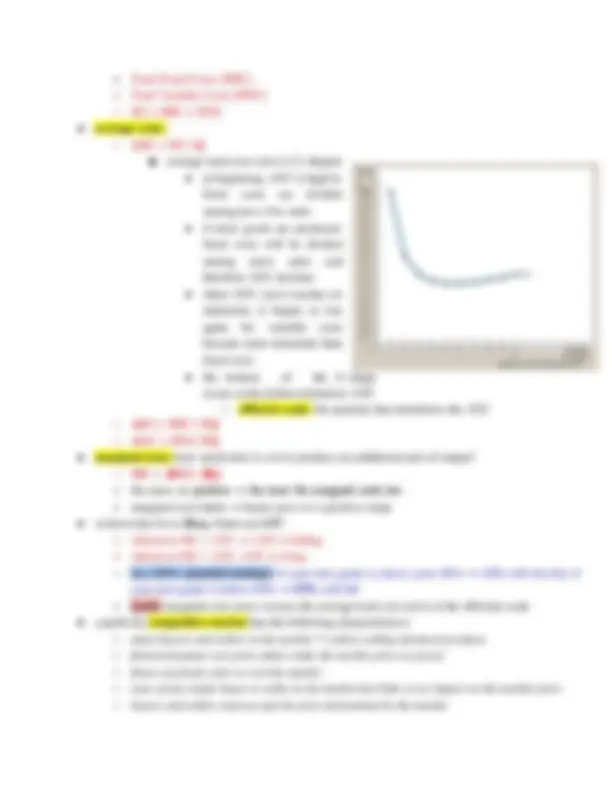
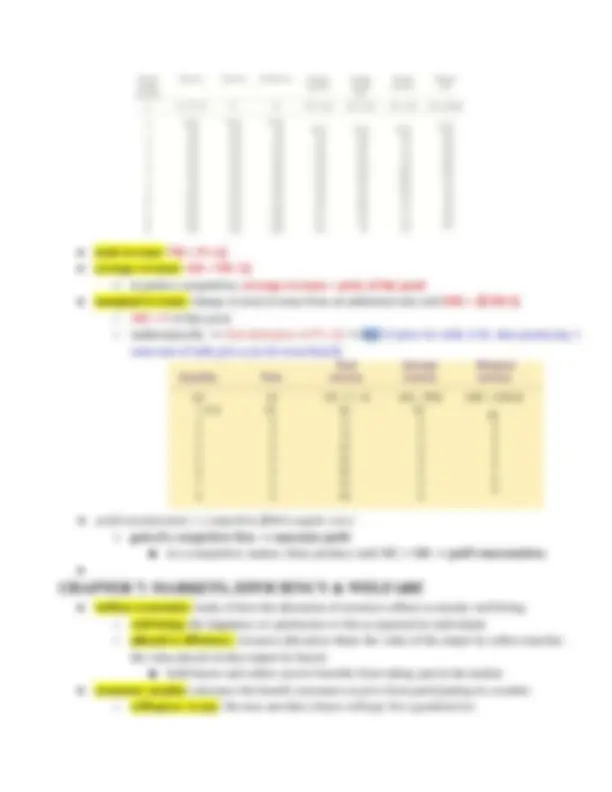

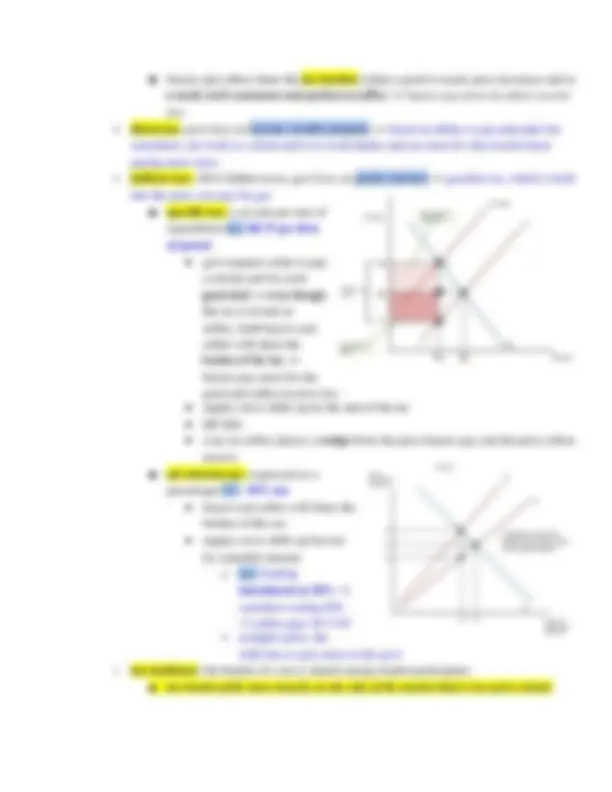
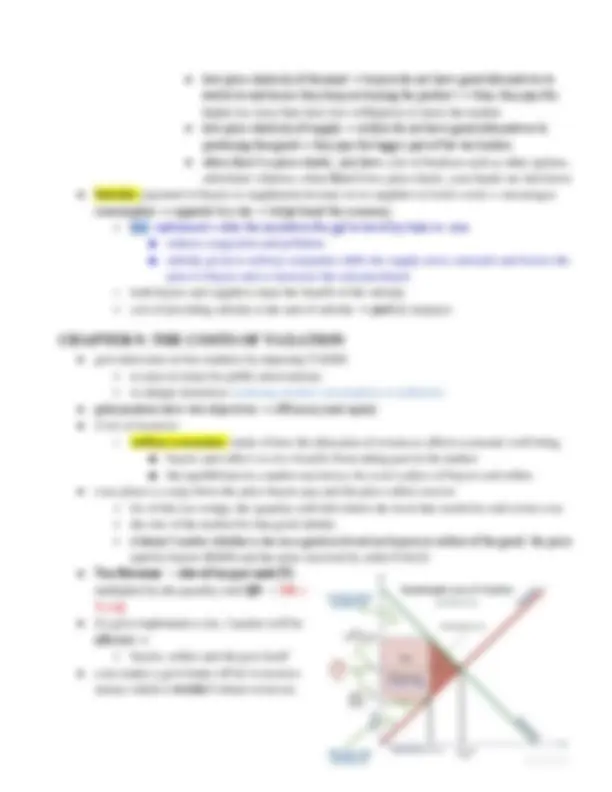
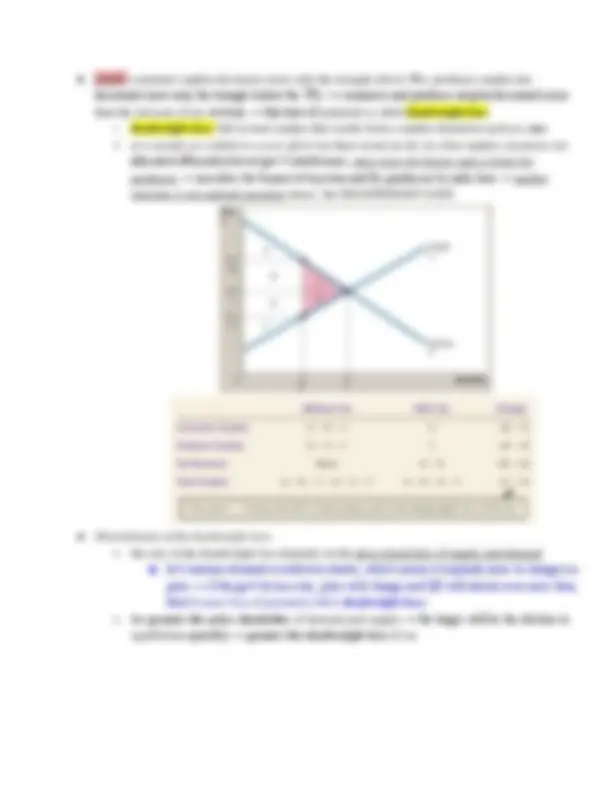
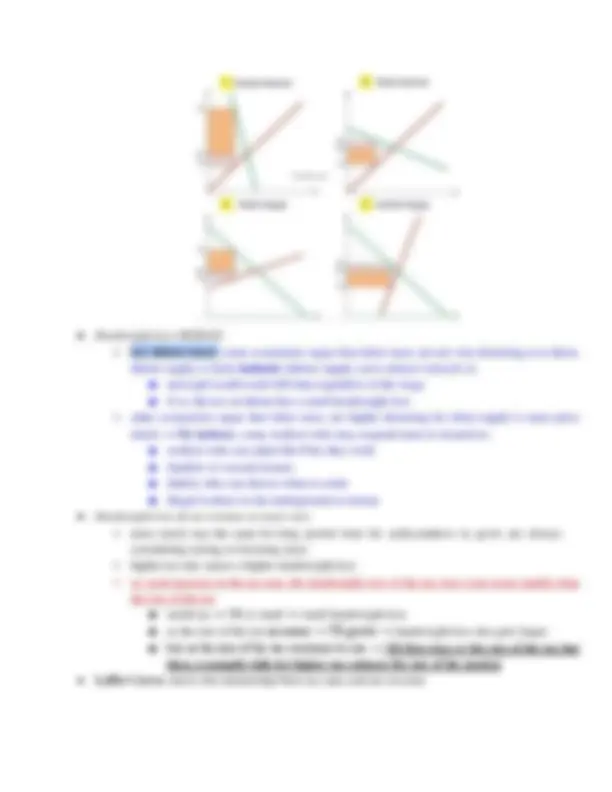
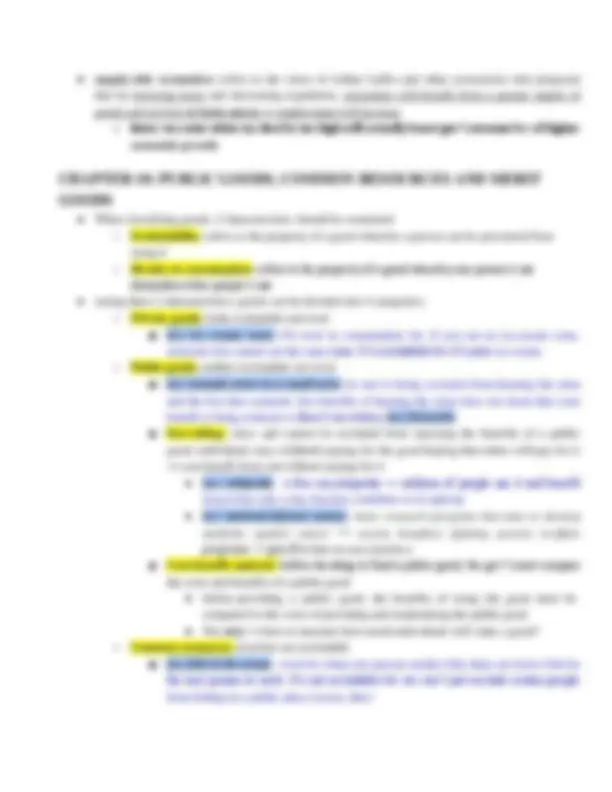
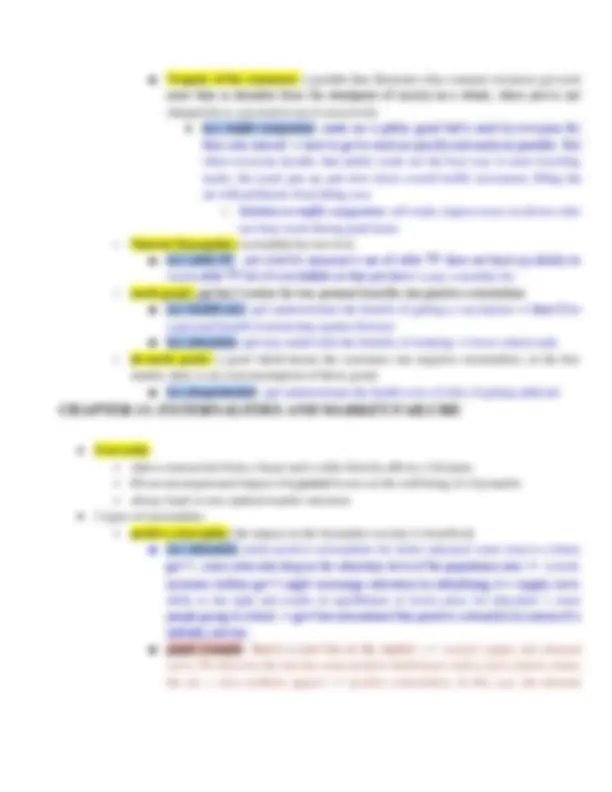
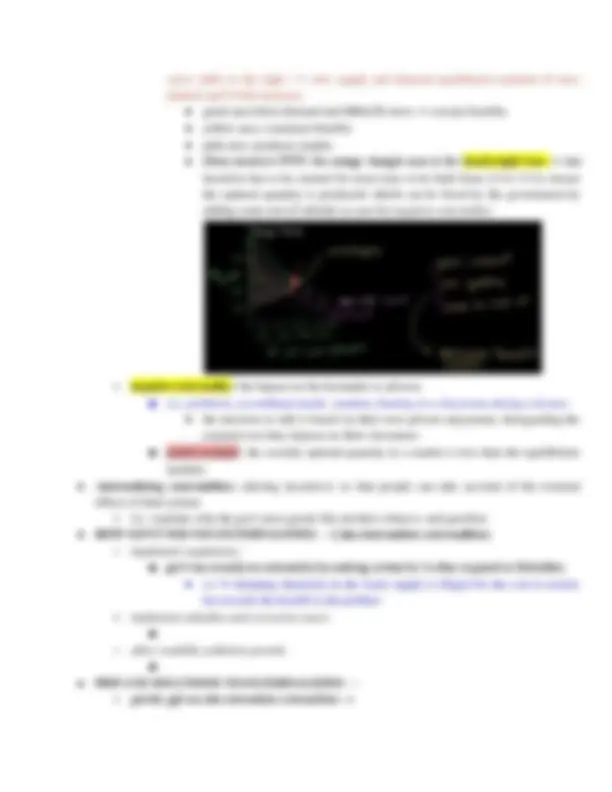
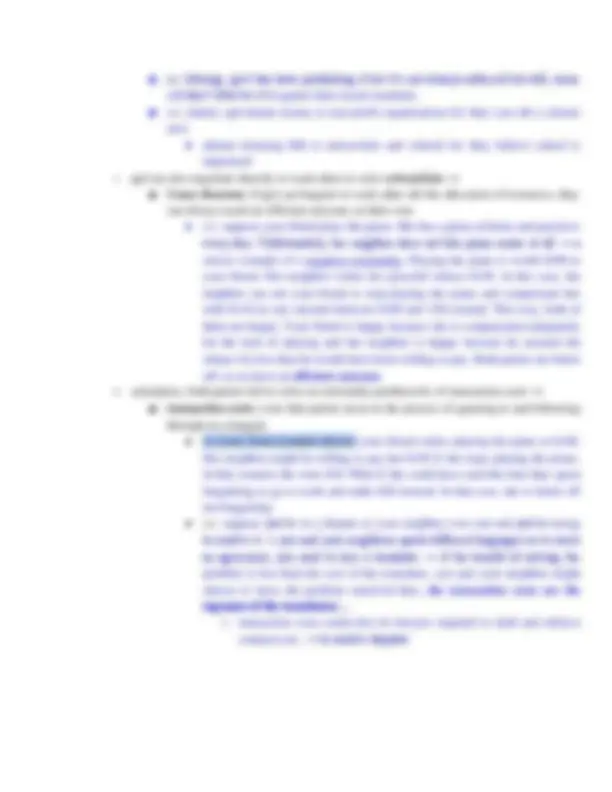
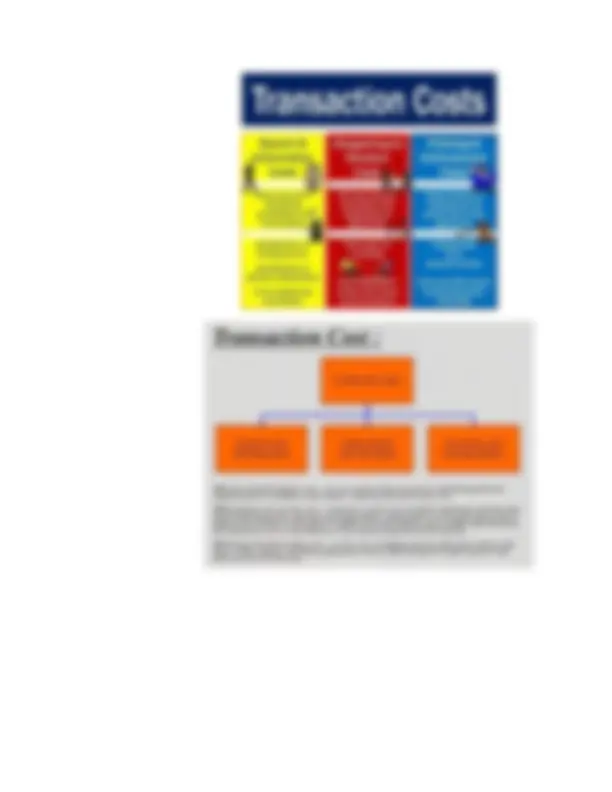


Study with the several resources on Docsity

Earn points by helping other students or get them with a premium plan


Prepare for your exams
Study with the several resources on Docsity

Earn points to download
Earn points by helping other students or get them with a premium plan
Community
Ask the community for help and clear up your study doubts
Discover the best universities in your country according to Docsity users
Free resources
Download our free guides on studying techniques, anxiety management strategies, and thesis advice from Docsity tutors
Various aspects of consumer behavior and market equilibrium, focusing on normal and inferior goods, demand curves, and the impact of taxes on market outcomes. It also discusses concepts such as giffen goods, bounded rationality, and discrimination by sellers. The document concludes with a discussion on the costs of taxation and the concept of deadweight loss.
Typology: Summaries
1 / 26

This page cannot be seen from the preview
Don't miss anything!



















lOMoARcPSD|
● economics is the study of how a society manages its scarce resources ● fundamental lessons about individual decision making ○ people face trade-offs among alternative goals ○ decisions are made by comparing costs and marginal benefits ○ ppl change bx in response to incentives ● fundamental lessons about interactions among ppl ○ trade and interdependence can be mutually beneficial ○ gov’t can improve market outcomes ● fundamental lessons abt the economy as a whole ○ productivity is the ultimate source of living standards ○ growth in the quantity of money → inflation ○ Society faces a short-run trade-off btwn inflation and unemployment ● 10 principles ○ how people make decisions ■ People face trade-offs ● I.e.: choosing btwn going to the cinema or working ■ Cost of smtn is what you give up to get it ● i.e.: during the time you were studying, attending classing you could have earned money working ■ Rational ppl think at the margin ● I.e.: when a firm decides whether to produce an extra unit of some good, it will always look at the cost of producing 1 extra unit vs. the benefit ■ Ppl respond to incentives ● I.e.: gov’t imposes a higher tax on cigarettes → ppl would stop smoking ○ how people interact ■ Trade can make everyone better off ● people specialize in the things they are good at so that they can trade with one another ● absolute advantage: ability to produce a good using fewer inputs than another producer ● comparative advantage : ability to produce a good at a lower opportunity cost than another producer ● gains from trade are based on comparative advantage because both parties will benefit when they specialize in smt where both will consume more goods and reach points outside the ppf ● graph: people face trade-offs btwn certain goods b/c their budget is limited so only the points inside and on the production possibility frontier are attainable however with trade, people will specialize and obtain points outside the curve.
● production possibilities curve: shows combo of output (capital+consumer goods) that the economoy can possibly produce. economy can produce anything on (points C, A) or inside the curve (B) but it’s considered inefficient since we have the resources to produce more → maybe this is due to widespread unemployment; points outside the curve (D) are unattainable given the economy’s resources but, w/ an increase in technological progress → it can shift the ppf curve upwards → we can produce according to D. ● Microeconomics: study of decisionmaking by households and the interaction among household and firms in the marketplace ● Macroeconomics: the forces and trends that affect the economy as a whole ● normative statement: claims that attempt to describe how the world ought to be; economists as policy advisers ○ I.e.: gov’t should raise the minimum wage ● positive statement: an assertion abt how the world is ○ I.e.: minimum-wage laws cause unemployment ● Key difference : how we judge their validity → we can confirm or refute positive statements by examining evidence vs. normative statement involve our view on ethics, religion, political philosophy
● supply and demand → forces that make market economies work ○ buyers determine demand ○ sellers determine supply ○ demand curve is downward sloping and supply curve is upward sloping ● market: group of buyers and sellers of a particular good or service ● competitive market: many buyers and sellers, each has a negligible impact on the market ○ i.e: ice-cream market → sellers do not charge more/less b/c customers can easily find the same ice cream elsewhere ○ perfectly competitive market characteristics: ■ goods offered for sale are exactly the same ■ many buyers and sellers such that no party has any influence on the price ● i.e: wheat market ● monopoly: 1 seller, and seller controls price
● oligopoly: few sellers→ not always aggressive competition ● quantity demanded: ○ change determined by factors such as income, prices of related goods, tastes, expectations and the number of buyers ■ a change in the price of the product → movement along the demand curve ■ a shift in the demand curve ← a factor other than a change in the price ● i.e: suppose new research says ice-cream makes you live longer → demand for ice-cream will increase → demand curve would shift to the right ● i.e: research suggests ice-cream is bad for your health → demand decreases → demand curve shifts to the left→ at any given price, you purchase less than before ■ consumer income: ● as income increases the demand for a normal good will increase ● as income increases the demand for an inferior good will decrease ○ i.e: bus ride ■ price of related goods : ● substitutes: a fall in the price of one good reduces the demand for another good ○ i.e: if the cost for frozen yogurt falls, the law of demand says you will buy more frozen yogurt → now, you will reduce your spending on ice-cream since both goods are similar ○ i.e: hotdogs + hamburgers; movie tickets + DVDs ● complementary goods: a fall in the price of one good increases the demand for another good ○ i.e: DVD and a DVD-player ● quantity supplied: change is determined by a change in anything that alters the quantity supplied at each price ○ a rise in the price → movement along the supply curve ○ change in a determinant other than the price → a shift to the left or right ■ decrease in supply → left ● i.e: input prices → price of sugar rises → producing ice cream is less profitable → supply less ice-cream ● i.e: number of sellers → if ben and jerry's retired from the ice-cream business, the supply of the market would fall ● i.e: expectation : if a firm expects the price of ice-cream to rise in the future → store its current product → sell in the future ■ increase in supply → shift to the right ● i.e: technology → less labour necessary to make ice-cream→ reduce firm’s costs → raise the supply
● Elasticity is always negative because the demand is always downward sloping → disregard the negative sign and refer to its absolute value (but w/ midpoint formula, this problem is gone) ● classification of elasticity: ○ Price elasticity of demand > 1 → elastic → quantity demanded does respond strongly to price changes ○ Price elasticity of demand < 1 → inelastic → quantity demanded doesn’t respond ” ○ Price elasticity of demand = 1 → unit elasticity → changes in price = quantity ● total revenue: the amount paid by buyers and received by sellers of a good ○ Computed as the price of the good times the quantity sold : TR = P x Q ○ inelastic demand curves: TR moves in the same direction as the price ○ elastic demand curves: TR moves in the opposite direction as the price ● income elasticity of demand: measures how much the Q demanded for a good changes when income changes by a certain percentage ○ ● Types of goods: ○ Normal goods: goods whose demand rise when consumers’ income rises ■ i.e: LCD tv, organic food, branded clothes ○ Inferior goods: goods whose demand decline when consumers’ income rises ■ i.e: canned vegetables, ramen, use of public transportation ● Price elasticity of supply: measures the change in quantity supplied after a change in price i.e: i.e.:
● “one is seeking to maximize their utility subject to the constraint of a limited income” ● standard economic model (SEM): AKA classical theory of consumer behaviour model that assumes rational behaviour → humans behave rationally when making consumption choices ○ people face trade-offs in their role as consumers ■ when making these trade-offs, assumptions abt consumers → ● buyers are rational ● more is preferred to less ● buyers seek to maximize their utility ● consumers act in self-interest and do not consider the utility of others ● utility : the satisfaction derived from the consumption of a product ○ ranking→ ordinal concept → can be used to rep consumer choices in some order ○ the amt buyers are prepared to to buy a good tells us smt abt the value they place on it ■ willingness to buy principle → i.e.: cheetah shoes for $75: Jo thinks they’re worth buying while Mel would never pay a dime for such kinda shoes ■ it’s not just the amt of $$$ we hand over that reflects value but what that money could’ve bought ○ opportunity costs: what was given up to make a purchase → i.e.: Mel believed she could’ve allocated that $75 to get more/better value → the alternative that money could buy repped greater value ● budget constraint: what the consumer can afford ○ ppl consume less than they desire b/c their spending is constrained by their income ■ i.e.: ppl usually want to take longer, fancier holidays but they consume less than desired b/c they’re limited by their income ○ graph: budget constraint shows the various combo of goods ( trade-off btwn 2 goods) the consumer can afford given his/her income + prices of the 2 goods ■ the slope of the budget constraint line measures the rate at which a consumer is willing to trade one good for another i.e:
● perfect complements: 2 goods w/ right-angle indifference curves ○ i.e.: left and right shoes → you only care abt pairs so your happiness would be the same if you had 7 left and 5 right shoes ● Optimization : what the consumer chooses ○ consumer wants to attain the highest indif. curve b/c he’s the happiest there but he also faces a budget constraint so he cannot buy unlimited amts of goods ○ point where the budget constraint is tangent to the indif. curve: point where a consumer’s utility is maximized given the budget constraint → utility maximization ○ if income rises, the budget constraint shifts to the right → we are able to attain a point on a higher indif. curve ■ when income rises, consumers buy more of normal goods ■ when income rises, consumers buy less of inferior goods i.e.: potatoes ○ price change → i.e.: suppose the price of Pepsi drops from $2 to $1/ pint. Consumer can now buy 1000 pints vs. 500 → new budget constraint rotates and has a steeper slope ○ price change has 2 effects on consumption → ■ income effect: consumer can reach a higher indif. curve → consume more pizza and pepsi b/c you’re richer ■ substitution effect: consumer moves along an indif. curve w/ a new, diff MRS→ consume more pepsi b/c it’s cheaper ● demand curves can sometimes slope upward ○ when a consumer buys more of a good when its price rises ○ giffen goods: goods for which an increase in the price increases the quantity demanded ■ they’re pretty rare ● Behavioural approaches to consumer bx: ○ bounded rationality: idea that humans make decisions under the constraints of limited and unreliable info ■ ppl are overconfident ■ give too much weight to a small number of observations ■ are reluctant to change their minds ■ have a tendency to look for examples which confirm their existing view ■ consumers use rules of thumb, common sense → heuristics
■ anchoring : using familiarity to make decisions; a cognitive bias that influences you to rely too heavily on the first piece of info you receive → JCPenney thought it was a smart move to eliminate coupons and instead create “everyday low pricing.” Too bad they weren’t aware of the power of the anchoring effect. When sales slid big time, they got the message. They’ve now reversed their policy and customers are returning. We need that anchor number to inform us that we’re getting a bargain.; ● i.e.2: If a husband is doing ten times more housework than his dad ever did, he may feel entitled to a “best husband of the year” award from his wife. Imagine his surprise then, when his wife berates him for not doing enough. What’s going on here? Blame it on the anchoring effect. His anchor is what his dad used to do. Her anchor is the amount of housework she does. ■ availability: when assessing relative risk/danger, a mental shortcut that makes fast, but incorrect, judgments→ what is the most dangerous job? high profile police shootings might lead you to think that cops have the most dangerous jobs ■ representativeness: decisions made based on how representative smtn is to a stereotype→ a person accused of abducting a child for ransom may be more likely to be viewed as guilty as someone accused of kidnapping an adult for no ransom. While both crimes represent kidnapping, the first is a more representative example because it fits better with what most people think of when they hear the word "kidnapping." ■ persuasion: attributes a consumer attaches to a product or brand → ‘bandwagon’ effect – if a large number of people go and see a movie and rave about it on FB then there is even more incentive for others to go and see it as well. Firms may look to try and create a bandwagon effect to utilize this persuasion heuristic in their marketing. ■ simulation: visualizing or simulating an outcome of smt → pharmaceutical firms know that consumers are more likely to buy and take medicine that deal with known and experienced symptoms (headaches, strained muscles, sore throats and runny noses) which are easy to visualize and imagine than taking regular medicine for smt like high cholesterol because it is hard to build a mental process for the effects of high cholesterol
● goal of firms is to maximize profit → profit = total revenue - total cost ○ total revenue : amt of money a firm receives for selling its products → ■ TR = PRICE x QUANTITY → 100 balls for $5 each = $ ○ total cost: sum of explicit and implicit costs ● cost of production: includes all the opportunity costs of output of goods/services ○ explicit costs: out of pocket costs for a firm ■ i.e.: wages a firm pays its workers, materials, rent
○ Total Fixed Costs ( TFC) ○ Total Variable Costs (TVC) ○ TC = TFC + TVC ● average costs: ○ ATC = TC / Q ■ average total-cost curve is U-shaped ● in beginning, ATC is high bc fixed costs are divided among just a few units ● if more goods are produced, fixed costs will be divided among more units and therefore ATC declines ● when ATC curve reaches its minimum, it begins to rise again b/c variable costs become more dominant than fixed costs ● the bottom of the U-shape occurs at the Q that minimizes ATC ○ efficient scale: the quantity that minimizes the ATC ○ AFC = TFC / TQ ○ AVC = TVC/ TQ ● marginal costs: how much does it cost to produce an additional unit of output? ○ MC = Δ TC/ Δ Q ○ the more we produce → the more the marginal costs rise ○ marginal cost curve → linear curve w/ a positive slope ● relationship btwn Marg. Cost and ATC ○ whenever MC < ATC → ATC is falling ○ whenever MC > ATC, ATC is rising ○ i.e.: GPA: (parallel analogy) if your next grade is above your GPA → GPA will rise but, if your next grade is below GPA → GPA will fall ○ graph: marginal cost curve crosses the average total cost curve at the efficient scale ● a perfectly competitive market has the following characteristics : ○ many buyers and sellers in the market → sellers selling identical products ○ firms/consumers are price takers (take the market price as given) ○ firms can freely enter or exit the market ○ axns of any single buyer or seller in the market has little or no impact on the market price ○ buyers and sellers must accept the price determined by the market
● total revenue: TR = P x Q ● average revenue: AR = TR / Q ○ in perfect competition, average revenue = price of the good ● marginal revenue: change in total revenue from an additional unit sold MR = Δ TR/ Q ○ MR = P of that good ○ mathematically → first derivative of P x Q → i.e.: if price for milk is $2, then producing 1 extra unit of milk gives you $2 extra benefit ● profit maximization + competitive firm’s supply curve ○ goal of a competitive firm → maximize profit ■ in a competitive market, firms produce until MC = MR → profit maximization ●
● welfare economics: study of how the allocation of resources affects economic well-being ○ well-being: the happiness or satisfaction w/ life as reported by individuals ○ allocative efficiency: resource allocation where the value of the output by sellers matches the value placed on that output by buyers ■ both buyers and sellers receive benefits from taking part in the market ● consumer surplus: measures the benefit consumers receive from participating in a market ○ willingness to pay : the max amt that a buyer will pay for a good/service
○ economic efficiency and waste → consumes spend money on goods which don’t have value; producers spend money on producing a good which consumers don’t want to buy ■ to reduce waste → consumers need to adjust their buying habits; producers adjust their production methods ○ allocative efficiency → an allocation of resources that maximizes the sum of consumer and producer surplus is said to be efficient ○ efficiency: if an allocation of resources maximizes total surplus, that allocation exhibits effic. ○ equality: distributing economic prosperity uniformly among members of society ○ Pareto efficiency: is said to occur when it’s impossible to make one individual better off without making someone worse off (a state where pareto improvement can occur) ■ i.e.: An economy contains two people and two goods, apples and bananas. Person 1 likes apples and dislikes bananas (the more bananas she has, the worse off she is), and person 2 likes bananas and dislikes apples. There are 100 apples and 100 bananas available. The only allocation that is Pareto efficient is that in which person 1 has all the applies and person 2 has all the bananas. For any other allocation, one of the persons has some units of the good she does not like, and would be better off if the other person had those units. ○ Pareto improvement: is said to occur when at least one individual becomes better off w/out harming another individual ■ i.e.: a group of people do not have electricity but overtime were able to install a small solar farm which brought electricity to their village. The electricity would allow the village to cook and heat their homes with electricity instead of charcoal which has harmful effects on the respiratory systems of the users. Assuming the electricity is accessible to everyone and the farm does not interfere with anyone in the village, it would be a Pareto improvement because the village is made better off without anyone being made worse off ● Efficiency and Equity: ○ equity: fairness of the distribution of well-being among various buyers and sellers ○ social welfare function: collective utility of society which is reflected by consumer and producer surplus
● in a free, unregulated market system, market forces establish equilibrium prices and exchange quantities ○ while equilibrium conditions may be efficient, it may be true that not everyone is satisfied therefore the Pareto efficiency principle is said to be weak b/c of equity issues ● Control Prices -- usually enacted when policymakers believe the market price is unfair to buyers/sellers → results in govt created price ceilings and floors
○ price ceiling: a legal maximum on the price → price is not allowed to rise above a certain amt, which is beneficial for customers ○ price floor: a legal minimum on the price at which a good can be sold ● Outcomes of price ceiling: ○ if price ceiling is set above the equilibrium price, then nothing will happen b/c market forces drive the price to the equilibrium level → price ceiling is not binding ○ price ceiling is binding if set below the equilibrium price → leads to a shortage ■ a binding price ceiling creates shortages b/c QD > QS ○ i.e.: rent control → local govt can limit how much a landlord can charge a tenant or by how much the landlord can increase prices annually. Rent control aims to ensure the quality and affordability of housing on the rental market. New York and San Francisco have famous rent control laws. Over the long-run, however, rent control decreases the availability of apartments, since suppliers do not wish to spend the money to build more apartments when they cannot charge a profitable rent. Landlords not only do not develop any more apartments, but they also do not maintain the ones that they have, not just to save costs but also because they do not have to worry about market demand since there is excessive demand for rent-controlled apartments. Hence, excess demand and limited supply lead to a massive shortage. ■ rent control in the short run : number of flats are given and we can’t change that → we assume the supply is given ■ rent control in the long run: can be adjusted to increase the supply ○ non- price rationing: process by which the market system allocates goods and services to consumers when QD > QS. Whenever there’s a need to ration a good (when a shortage exists) in a free market, the price of the good will rise until QS = QD → until market clears ■ queuing: a non price rationing mechanism → waiting in line as a means of distributing goods and services ● the cost of a product = price of product + waiting time ● i.e.: doctor queues (USSR) ■ discrimination by sellers: favored customers who receive special treatment from dealers during situations of excess demand ● outcomes of price floor: ○ price floor is not binding if set below the equilibrium price ○ price floor is binding if set above the equilibrium price → surplus → QS > QD ○ i.e.: minimum wage → if min. wage is set above equilibrium level → companies are less willing to hire ppl and unemployment occurs ● Taxes affect the outcome of a market → govts levy taxes to raise revenue for public projects ○ H/e → taxes discourage market activity (can have a negative effect on bx) and result in a change in market equilibrium; when a good is taxed, the Q sold is smaller;
● low price elasticity of demand → buyers do not have good alternatives to switch to and hence they keep on buying the product → thus, they pay the higher tax since they have less willingness to leave the market ● low price elasticity of supply → sellers do not have good alternatives to producing this good→ they pay the bigger part of the tax burden ● when there’s a price elastic, you have a lot of freedom such as other options, substitutes whereas, when there’s less price elastic, your hands are tied down ● Subsidy: payment to buyers to supplement income (or to suppliers to lower costs) + encourages consumption → opposite to a tax → helps boost the economy ○ i.e.: rail travel → alter the incentives for ppl to travel by train vs. cars ■ reduces congestion and pollution ■ subsidy given to railway companies shifts the supply curve outwards and lowers the price to buyers and so increases the amt purchased ○ both buyers and suppliers share the benefit of the subsidy ○ cost of providing subsidy is the amt of subsidy → paid by taxpayer
● govt intervenes in free markets by imposing TAXES ○ to raise revenue for public interventions ○ to change incentives (reducing alcohol consumption or pollution) ● policymakers have two objectives → efficiency and equity ● Costs of taxation: ○ welfare economics: study of how the allocation of resources affects economic well being ■ buyers and sellers receive benefits from taking part in the market ■ the equilibrium in a market maximizes the total welfare of buyers and sellers ● a tax places a wedge btwn the price buyers pay and the price sellers receive ○ b/c of this tax wedge, the quantity sold falls below the level that would be sold w/out a tax ○ the size of the market for that good shrinks ○ it doesn’t matter whether a tax on a good is levied on buyers or sellers of the good: the price paid by buyers RISES and the price received by seller FALLS ● Tax Revenue → size of tax per unit (T) multiplied by the quantity sold QS → TR = T x Q ● if a govt implements a tax, 3 parties will be affected → ○ buyers, sellers and the govt itself ● a tax makes a govt better off b/c it receives money which it wouldn’t obtain w/out tax
● graph: consumer surplus decreases (now only the triangle above TR); producer surplus has decreased (now only the triangle below the TR) → consumer and producer surplus decreased more than the increase of tax revenue → this loss of potential is called deadweight loss ○ deadweight loss: fall in total surplus that results from a market distortion such as a tax ○ so a society as a whole is worse off w/ tax than w/out tax b/c in a free market, resources are allocated efficiently but w/ gov’t interference, price rises for buyers and is lower for producers → incentive for buyers to buy less and for producers to make less → market outcome is not optimal anymore hence, the DEADWEIGHT LOSS ● Determinants of the deadweight loss: ○ the size of the deadweight loss depends on the price elasticities of supply and demand ■ let’s assume demand is relatively elastic, which means it responds more to changes in price → if the govt levies a tax, price will change and QD will shrink even more thus, there’s more loss of potential (AKA deadweight loss ) ○ the greater the price elasticities of demand and supply → the larger will be the decline in equilibrium quantity → greater the deadweight loss of tax